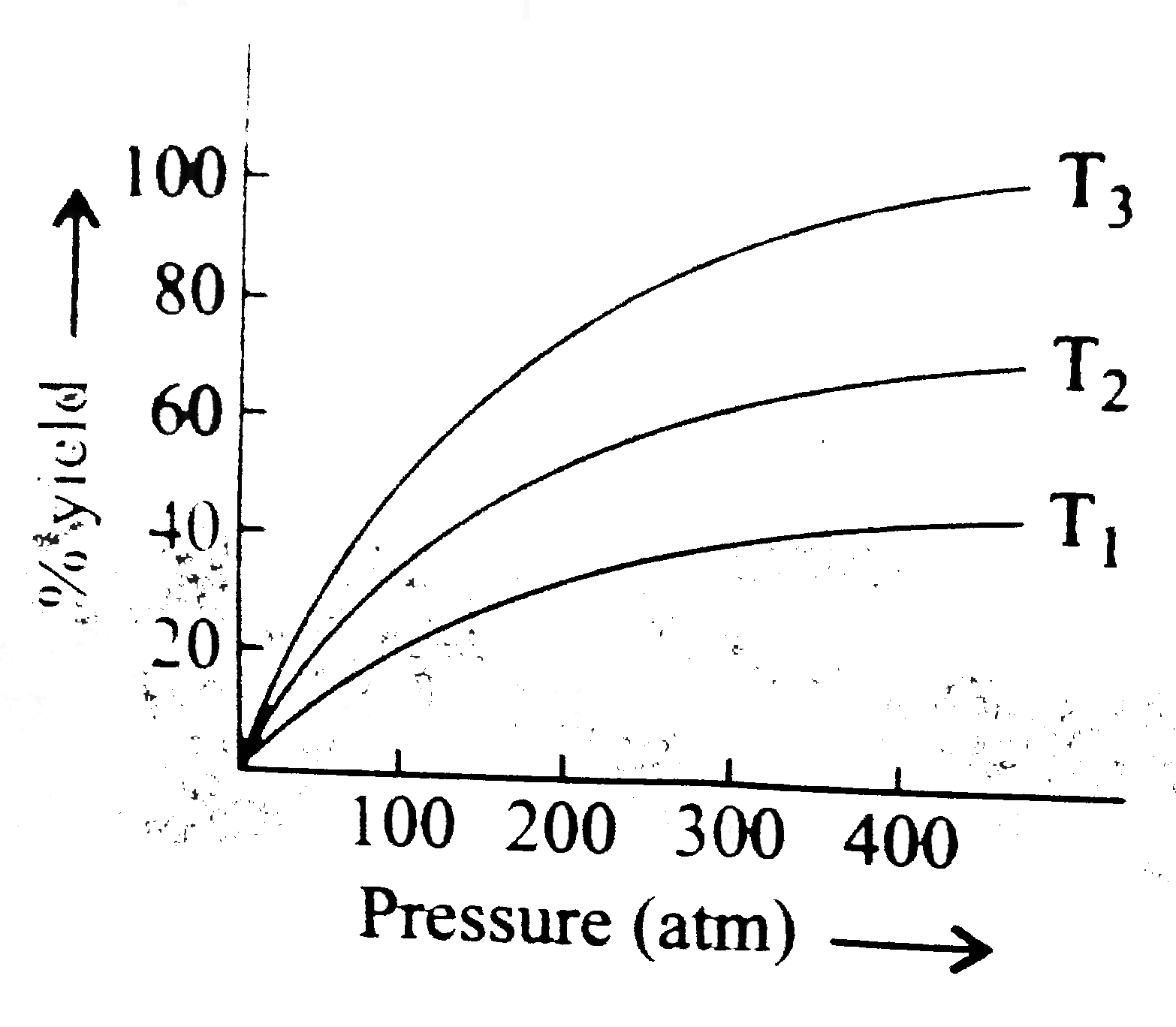N2(g)+3H2(g)⇔2NH3(g),ΔHɵ=−22.4kJ
The pressure inside the chamber is 100 atm and temperature at 300K
On adding catalyst the equilibrium of reaction:
Shift in backward direction
Shift in forward direction
Does not affect the equilibrium
Cannot predict.
The correct Answer is:C
To solve the question regarding the effect of a catalyst on the equilibrium of the reaction N2(g)+3H2(g)⇌2NH3(g) under the given conditions, we can follow these steps:
1. Understand the Reaction: The reaction provided is the formation of ammonia from nitrogen and hydrogen gases. The reaction is exothermic, as indicated by the negative enthalpy change (ΔH∘=−22.4kJ).
2. Identify the Role of a Catalyst: A catalyst is a substance that increases the rate of a chemical reaction without being consumed in the process. It does this by providing an alternative pathway for the reaction with a lower activation energy.
3. Effect of Catalyst on Equilibrium: While a catalyst speeds up the rate at which equilibrium is reached, it does not change the position of the equilibrium or the equilibrium constant. This means that the concentrations of reactants and products at equilibrium remain the same, regardless of the presence of a catalyst.
4. Conclusion: Since the catalyst does not affect the equilibrium position or the equilibrium constant, the equilibrium of the reaction will remain unchanged after the addition of the catalyst. It will only allow the system to reach equilibrium faster.
Final Answer:
The addition of a catalyst does not affect the equilibrium position of the reaction N2(g)+3H2(g)⇌2NH3(g). It only helps the system to reach equilibrium more quickly.
The addition of a catalyst does not affect the equilibrium position of the reaction N2(g)+3H2(g)⇌2NH3(g). It only helps the system to reach equilibrium more quickly.
Topper's Solved these Questions
- CHEMICAL EQUILIBRIUMBOOK - CENGAGE CHEMISTRY ENGLISHCHAPTER - CHEMICAL EQUILIBRIUMEXERCISE - Exercises (Multiple Correct)
26 Videos
- CHEMICAL EQUILIBRIUMBOOK - CENGAGE CHEMISTRY ENGLISHCHAPTER - CHEMICAL EQUILIBRIUMEXERCISE - Exercises (Single Correct)
58 Videos
- CHEMICAL EQUILIBRIUMBOOK - CENGAGE CHEMISTRY ENGLISHCHAPTER - CHEMICAL EQUILIBRIUMEXERCISE - Exercises (Subjective)
46 Videos
- CHEMICAL BONDING AND MOLECULAR STRUCTUREBOOK - CENGAGE CHEMISTRY ENGLISHCHAPTER - CHEMICAL BONDING AND MOLECULAR STRUCTUREEXERCISE - Archives Subjective
15 Videos
- CLASSIFICATION AND NOMENCLATURE OF ORGANIC COMPOUNDSBOOK - CENGAGE CHEMISTRY ENGLISHCHAPTER - CLASSIFICATION AND NOMENCLATURE OF ORGANIC COMPOUNDSEXERCISE - Analytical and Descriptive Type
3 Videos
Similar Questions
N2(g)+3H2(g)⇔2NH3(g),ΔHɵ=−22.4kJ
The pressure inside the chamber is 100 atm and temperature at 300K
If Kp for the given reaction is 1.44×10−5, then the value of Kc will be:
View SolutionN2(g)+3H2(g)⇔2NH3(g),ΔHɵ=−22.4kJ
The pressure inside the chamber is 100 atm and temperature at 300K
The preparation of ammonia by Haber's process is an exothermic reaction. If the preparation follows the following temperature-pressure relationship for its % yield. Then for temperature T1,T2 and T3 the correct option is:

View SolutionN2(g)+3H2(g)⇔2NH3(g),ΔHɵ=−22.4kJ
The pressure inside the chamber is 100 atm and temperature at 300K
If Kp for the reaction is 1.44×10−5, then the value of Kp for the decomposition of NH3
2NH3(g)⇔N2(g)+3H2(g)
will be:
View SolutionFor the reaction
N2(g)+3H2(g)⇔2NH3(g),ΔH=?
View SolutionThe synthesis of ammonia is given as:
N2(g)+3H2(g)⇔2NH3(g),ΔHɵ=−92.6kJmol−1 given Kc=1.2 and temperature (T)=375∘C
On increasing the temperature, the value of equilibrium constant Kc
View SolutionThe synthesis of ammonia is given as:
N2(g)+3H2(g)⇔2NH3(g),ΔHɵ=−92.6kJmol−1 given Kc=1.2 and temperature (T)=375∘C
The expression of equilibrium constant is
View SolutionFor the reaction : N2(g)+3H2(g)⇔2NH3(g), ΔH=−ve, the correct statement is :
View SolutionThe synthesis of ammonia is given as:
N2(g)+3H2(g)⇔2NH3(g),ΔHɵ=−92.6kJmol−1 given Kc=1.2 and temperature (T)=375∘C
Which of the following factors does not alter the yield of NH3 at equilibrium?
View SolutionIn reaction N2(g)+3H2(g)⇔2NH3(g),ΔH=−93.6kJ/mole, the yield of ammonia does not increase when
View SolutionThe synthesis of ammonia is given as:
N2(g)+3H2(g)⇔2NH3(g),ΔHɵ=−92.6kJmol−1 given Kc=1.2 and temperature (T)=375∘C
The relationship between Kp and Kc for this reaction is
View Solution
